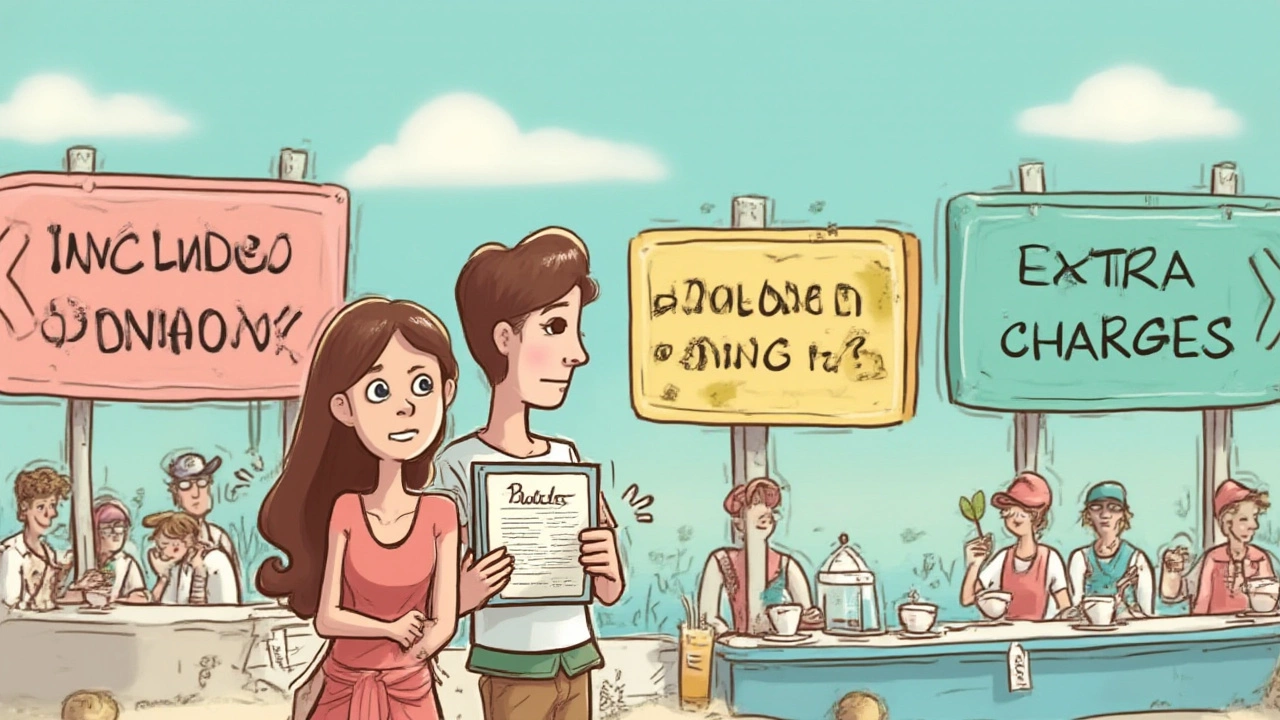Ever been lured in by a dreamy hotel ad promising "all-inclusive luxury" then wondered if you’ll end up secretly billed for each sandwich or cocktail? The truth is, all-inclusive means different things in different places, and plenty of travelers get caught out by small print. This world can be a confusing maze of wristbands, buffets, and hidden costs. Come with me and let’s break it down so you aren't left trying to dodge surly waiters while fumbling for your wallet beside the pool.
What Actually Counts as All-Inclusive?
When a hotel says “all-inclusive,” it usually means your room, food, drinks, and many on-site activities are bundled into the price you pay up front. But—and this is a big but—not every all-inclusive is created equal. Some resorts offer unlimited everything, including top-shelf liquors and à la carte dining. Others might stick you with buffet-only meals and basic beer, charging extra for fancier dishes and even bottled water. The phrase "all-inclusive" is sort of like "unlimited data" from phone companies: what you get depends on the fine print.
Here's a stunning fact: according to a 2023 survey by Skift Research, nearly 38% of travelers said they felt surprised by unexpected charges at their all-inclusive resort. Why? Because not all hotels spell out what’s included in an easy-to-understand way. Some throw in loads of extras—think room service, snacks all day, or complimentary beach sports. Others, especially at budget resorts, limit you to main meals and strip out premium perks.
For families, the promise of a set price for everything (no surprise ice cream bills after a day at the pool) can be a lifesaver. But adults splurging for luxury should double-check menus and inclusions before booking. Just because the ad spot says "gourmet" doesn’t always mean lobster tail and fancy cocktails are on the house. And keep in mind, hotels in the Caribbean and Mexico are generally much more generous with what's included compared to European all-inclusives, which often add nasties like tourist taxes or charge extra for espresso and imported spirits.
The devil’s in the details. Is the minibar restocked daily at no charge? Is kids’ club free, or does it eat into your spending money? Ask about theme nights, entertainment, room service, and whether specialty restaurants require reservations or an extra fee. A friend who stayed at a "five-star" all-inclusive in Spain last year ended up forking out €8 every time her daughter wanted a scoop of gelato. Cheeky, isn’t it?
It pays to scan your booking confirmation for terms like “full-board,” “half-board,” and “all-inclusive plus.” Here’s a quick breakdown in a all-inclusive comparison table:
| Plan Type | Meals Included | Beverages | Extras |
|---|---|---|---|
| Full-Board | Breakfast, lunch, dinner | Usually not included | None or paid |
| Half-Board | Breakfast and dinner (sometimes lunch) | Usually not included | None or paid |
| All-Inclusive | Breakfast, lunch, dinner, snacks | Locally-available drinks (soft & alcohol) | Hotel activities, select entertainment |
| All-Inclusive Plus | All regular meals plus à la carte & premium options | Top-shelf drinks, international brands | Room service, minibar, exclusive activities |
The Food: Free vs. Paid, and What’s Available
Let’s get to the question: Is the food really free? Yes—if you don’t wander off the “options included” path. At most all-inclusives, standard fare is paid for upfront. This includes breakfast, lunch, dinner, snacks, and whatever buffet or casual dining is available. But just because you can eat for “free,” doesn’t mean every menu item at every restaurant is covered.
One thing I learned the hard way—some resorts reserve their fancier restaurants for extra fees or special reservations. Even within those, there might be “select dishes” (usually lobster, steak, or imported cheese boards) that aren’t included in your plan. I stayed at a Mexican resort where the basic tacos and ceviche were included, but the sushi bar and steakhouse had surcharges, sometimes as high as €20 per plate. That adds up.
It’s worth checking: Does the hotel offer 24/7 food service? Are snacks and drinks near the pool or beach included, or just the main dining halls? Many Caribbean and Turkish resorts boast snack bars, pancake houses, and swim-up bars you can visit all day with zero bill at check-out. In contrast, most Spanish all-inclusives stick to set mealtimes, and, after hours, you may only get snacks or cold sandwiches.
Here’s a quick checklist to help you spot what food is actually “free” at your all-inclusive:
- Are all main meals — breakfast, lunch, dinner — covered with no surprise charges?
- Is there a choice between buffet and à la carte dining, or do à la carte restaurants have surcharges?
- Are room service, minibar snacks, and late-night nibbles included?
- Does the hotel have special nights (barbecues, seafood feasts) and are these included?
- Are dietary restrictions (coeliac, vegan, halal) catered for at no extra cost?
If you see “premium” or “gourmet” attached to a restaurant name, double-check if it's included. Another hot tip: ask about beverage coverage—the difference between locally produced versus imported drinks can sting your wallet. For example, in Greece, local ouzo or house wine is typically part of the deal, but that gin and tonic made with imported Tanqueray might set you back €6 per glass.
And don’t forget about kids’ food options. The best family resorts set up 24/7 ice cream stands and all-you-can-eat pizza or hot dogs, while others limit kids’ menus to the main buffet. It matters when you're parenting hangry little ones.

Hidden Extras: What’s Not Included at All-Inclusive Resorts
This is where many travelers stumble. That magical "all-inclusive" bracelet doesn’t mean your wallet is finally on holiday too. There are classic traps: spa treatments, special fitness classes (think Pilates, yoga on the beach), motorized water sports, golf courses, and off-site excursions almost always cost extra.
Take laundry service, for example. It’s rare to find an all-inclusive that offers this for free, even at the luxury end. Want to pop into the spa for a massage or facial? Those are usually charged at premium rates, sometimes pricier than at home. Some resorts, clever as ever, will offer a daily “credit” — say, €50 for spa use — but then price treatments at €100-plus. Beware the kid’s club too: while basic supervised play is usually included, evening babysitting or special activities (like pony rides or laser tag) may show up on your bill.
For drinks, watch out for these sneaky up-charges:
- Imported premium alcohols (think Grey Goose vodka, Veuve Clicquot champagne)
- Wine by the bottle versus house wine by the glass
- Espresso, cappuccino, or fresh juices (often only local beer, fizzy drinks, filter coffee included)
- Drinks outside designated hours (midnight snacks might only be self-serve water or tea)
Room upgrades and late check-outs? Still extra, even at five-star resorts. Same thing for airport transfers unless you’re at one of the ultra-premium brands like Sandals or Club Med, where some services are genuinely all-in.
Wi-Fi is another gotcha. While free Wi-Fi is almost standard nowadays, budget all-inclusives in Spain, Italy, and Egypt sometimes restrict access to the lobby or sting you for high-speed connections in your room. Even in 2025, a surprising number of big-name beach resorts squeeze out extra cash from holidaymakers who can’t live without streaming Netflix poolside.
If in doubt, scan traveler forums or recent reviews for hidden extras—TripAdvisor, Facebook travel groups, and even TikTok are goldmines for spill-the-beans stories. Better yet, email the resort before you go, and have them confirm in writing what's genuinely included.
Tips to Get the Most From Your All-Inclusive Stay
Alright, you’ve booked your dreamy escape and want to get every penny’s worth. Here’s how to squeeze maximum value from your all-inclusive:
- Go early to meals, especially specialty restaurants with limited seats. Book à la carte spots as soon as you arrive (some resorts have apps or kiosks for this now).
- Try everything on offer, from pool snacks to local cocktails at the swim-up bar. Don’t be shy—staff expect you to indulge.
- Bring your own reusable bottle and fill up at drink stations; this beats paying silly money for bottled water.
- Check out daily activity schedules—water aerobics, dance lessons, or cooking demos are usually included and a great way to meet other guests.
- Ask about off-the-menu or “hidden” items staff sometimes reveal to regulars (like a secret menu or prepared cocktails not listed in the brochure).
- Families: find out if kids’ clubs have rotating programmes. Sneak a peek at the entertainment schedule too—magic shows, movie nights, or game competitions are often free extras.
- Bring a stash of small bills (in euros, dollars, or local currency)—tips aren’t usually required but can mean next-level service or a few extra perks (think prime poolside seating or a surprise dessert for your kids).
- Avoid the "tournament" mentality—filling up your plate with everything just because it’s paid for isn't always fun. Prioritize experiences instead: try local specials, join themed dinners, and sip regional drinks.
- If you have dietary restrictions or food allergies, speak to the restaurant staff on day one—many kitchens will go the extra mile to keep you safe and happy, but only if you give them a heads-up.
One fun tip: if the resort offers daytime excursions like snorkeling, zip lining, or city tours and they aren’t included, check for local providers outside the hotel gates. They often charge less than the in-house tour desk and you’ll get a more authentic (and less crowded) experience.

Popular Destinations and How They Handle All-Inclusive
Not all destinations treat all-inclusive the same, so where you go matters almost as much as where you stay. If you dream of wandering straight from ocean to buffet in your flip-flops, consider these hot spots:
- Caribbean and Mexico: Here, the all-inclusive system is king. Jamaican, Dominican, and Mexican resorts generally include everything down to airport shuttles, top-shelf cocktails, and even butler service in some cases. The competition is fierce—so standards are high, and value is better.
- Spain, Greece, Turkey: Many seaside resorts offer all-inclusive, but coverage varies a lot. In Spain, the Balearic Islands recently cracked down on "excessive drinking," so some Mallorca and Ibiza hotels now cap free alcoholic drinks at mealtimes. Greece is more generous with buffets, but charges for imported spirits. Turkey often leads the pack for value—all-you-can-eat buffets and constant snacking at most hotels, but spa and motor sports usually cost extra.
- Egypt and Morocco: Decent all-inclusives abound in Sharm el-Sheikh and Marrakesh—lots of food, but coffee, Wi-Fi, and some activities can have extra fees. Keep an eye on the fine print.
- Thailand, Bali, Indian Ocean: All-inclusive is less common, usually at higher-end resorts for honeymooners or luxury junkies. Expect plenty of included dining, but spa treatments and excursions are almost always extra.
If you want a truly “no wallet required” break, look up brands like Club Med or Sandals, which set the gold standard for all-inclusives (with the price tag to match). They’re known for fewer exclusions and better-quality food and drink compared to mass market resorts.
So, does all-inclusive hotel mean free food? Most of the time, yes—but it pays to be savvy. Ask questions, double-check the fine print, and you’ll eat, drink, and relax without a single unexpected bill. One less thing to stress about, which, let’s face it, is the dream.
